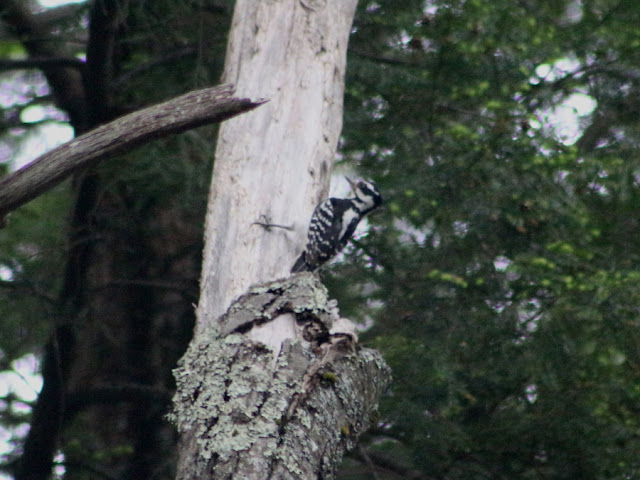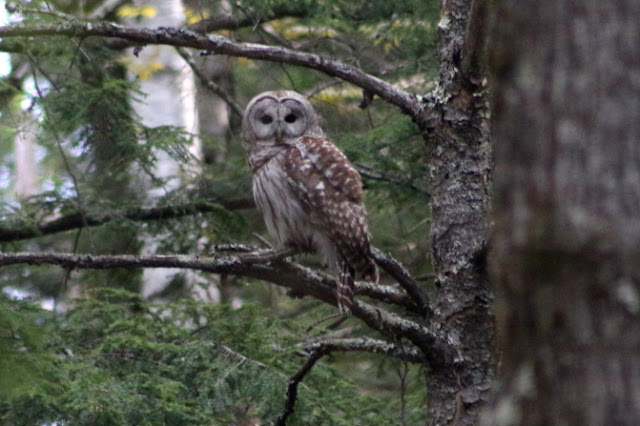The weather on this Memorial Day Weekend certainly isn't what we're hoping for, especially after the past couple weeks of hot, summer-like weather had spoiled us terribly. The flowers, trees, and even animals however are very thankful for the rain and some cooler temperatures, including our little family of mallards. They continue to dabble in the cove, fly in and out for unknown reasons, and still scour the road for acorns. They must have the ability to smell those big seeds even after they've been packed down into the ground because every morning there are little funnel holes in the road where they've been excavating. One morning I watched them in action:
 |
| Mr. Mallard zeros in on an invisible target. |
 |
| He probes down into the ground, |
 |
| And plucks up a tasty morsel. |
 |
| Down the hatch! |
All that good nutrition combined with a lot of effort to defend their territory has produced results. This week we saw mom in tow with five little chicks.
 |
| Five little ducklings follow mom in tight formation. |
They had been so good at concealing their nest, and the chicks so quiet, that we never discovered where the nest was situated, though we knew its approximate location because dad would be stationed right off shore on a regular basis while (we assume) mom was on the nest.
Another bird species is not nearly so careful in keeping their presence secret. Walking through the woods on Friday I heard a loud, high pitched peep-peep-peep-peep-peep coming from somewhere in the forest. I stopped to see if I could figure out what it was and where it was coming from, and I found that making noise walking on the leaves and fallen branches only made the peeping more adamant. This hinted that it was undisciplined baby birds thinking a meal was heading their way via mom or dad, unlike an adult animal that would be quiet when it detected an approaching creature. The piercing sound was rather easy to track down and I soon found the source of the racket which was emanating from a small hole in an ash tree.
 |
| The source of the noise. |
I didn't expect to see the parents anytime soon after tramping around the area so I left, but came back late that evening, quietly, and settled in a discreet spot to see if I could learn who's nest it was. It took only about ten minutes before two loud birds came flying into the trees near the area, landed where I couldn't see them, and started sending out dramatic alert calls which told me they knew something wasn't right (me). Nonetheless, after a few minutes of this, a downy woodpecker - the female - flew onto the tree below the hole with a good size morsel of food that looked like a large insect, in its beak.
 |
| Bringing home dinner for the hungry kids. |
She spent a few moments doing the woodpecker jig, jerking her head one way and the other to survey the surroundings before poking her head into the hole, then disappearing inside.
 |
| "Hi kids" |
She was in the tree for a minute or two before scooting out quickly, immediately landing on a nearby dead tree to begin her search for another insect to bring home.
 |
| Back at the supermarket. |
We've entered the peak period of bird hatching, so keep an eye for all flavors of baby birds throughout the forests and lakes. Ducklings and Canada goose goslings will be some of the most visible, but robin and phoebe chicks are also occasionally seen. Loons won't be hatching for several more weeks - the only pair that appears to have returned to Lake Wicwas is still searching out nesting sites. There also continue to be battles over territory and/or mates on Wicwas. This week I watched a long altercation take place, long enough to decide to get my camera and see if I could catch some it on video - which I did, still getting over two minutes of action before they went out of sight, and I don't know how long the battle continued after that. The action was far away, and hand-holding a telephoto lens makes for poor video, but you can at least get the idea of what was taking place if you watch it:
And here's a short clip of a wing-rowing event:
Perhaps you saw the announcement that the Meredith Conservation Commission is holding the second of its summer guided walk series at the Hamlin-Eames Conservation Area. The walk will start with a brief memorial to Peter Miller who passed away last November and a dedication of a plaque in his memory. Peter was a Meredith conservation commissioner who designed the trails in Hamlin and Eames and led the fund raising effort to purchase the Eames property. There will be guided walks ranging from one third of mile up to three miles. If you would like to participate, meet at the Hamlin Trailhead on Chemung Rd at 10:00am on Saturday, June 5th.
It's also National Trails Day - I hope to see you there!













































